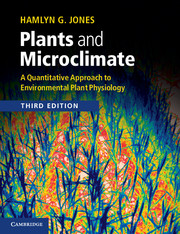Book contents
- Frontmatter
- Contents
- Preface
- Acknowledgements
- Symbols
- Main abbreviations and acronyms
- 1 A quantitative approach to plant–environment interactions
- 2 Radiation
- 3 Heat, mass and momentum transfer
- 4 Plant water relations
- 5 Energy balance and evaporation
- 6 Stomata
- 7 Photosynthesis and respiration
- 8 Light and plant development
- 9 Temperature
- 10 Drought and other abiotic stresses
- 11 Other environmental factors: wind, altitude, climate change and atmospheric pollutants
- 12 Physiology and crop yield improvement
- Appendices
- References
- Index
12 - Physiology and crop yield improvement
Published online by Cambridge University Press: 05 June 2014
- Frontmatter
- Contents
- Preface
- Acknowledgements
- Symbols
- Main abbreviations and acronyms
- 1 A quantitative approach to plant–environment interactions
- 2 Radiation
- 3 Heat, mass and momentum transfer
- 4 Plant water relations
- 5 Energy balance and evaporation
- 6 Stomata
- 7 Photosynthesis and respiration
- 8 Light and plant development
- 9 Temperature
- 10 Drought and other abiotic stresses
- 11 Other environmental factors: wind, altitude, climate change and atmospheric pollutants
- 12 Physiology and crop yield improvement
- Appendices
- References
- Index
Summary
This chapter introduces some of the ways in which information of the type discussed in earlier chapters can be applied to the improvement of crop yields. Farm yields have been improving over hundreds of years, though the rate of increase has been particularly rapid in the last 70 years or so (Figure 12.1(a)). These yield increases have resulted both from the introduction of new varieties and from advances in crop management (agronomy), including both the widespread use of fertilisers, herbicides, pesticides and fungicides, and improvements in machinery and irrigation. In addition to their increased yield potential, the new varieties that have been developed by plant breeders often incorporate improved pest or disease resistance and the ability to benefit from increased levels of fertiliser application; in cereals this is partly because newer dwarf genotypes are resistant to lodging. The ‘green revolution’ in the 1960s and 1970s was based on both the incorporation of dwarfing genes that conferred resistance to lodging and improved the harvest index (HI; the proportion of dry matter that is in harvestable yield) and on the introduction of photoperiod insensitivity genes that allowed the improved crops to be grown over a wide range of environments.
It is useful when discussing yield increases to distinguish between potential yields achieved with optimal agronomy under experiment station conditions, and farm yields as obtained by typical farmers and reported in national yield statistics (Figure 12.1(b)).
- Type
- Chapter
- Information
- Plants and MicroclimateA Quantitative Approach to Environmental Plant Physiology, pp. 321 - 342Publisher: Cambridge University PressPrint publication year: 2013

